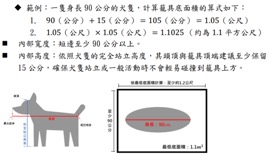
In February 2022, Taiwan’s animal protection administrative authorities announced the Guide to the Breeding and Care of Dogs (hereinafter referred to as the Dog Breeding Guide). Although it did not attract widespread attention, it has indelible significance in the history of animal welfare in Taiwan, as it declared that all pets, regardless of species, should have an exclusive Breeding Guide, making it imperative for carers to maintain both their physical and psychological health. Following the official version of the Dog Breeding Guide, the private sector has taken over and produced Breeding Guides for rabbits, rats, hedgehogs and birds, with considerable success.
There are dozens of books and picture books on how to keep dogs, so why did the government go to the trouble of producing a separate guide on dog breeding? The 15-page guide begins by stating that the main objective is to establish animal welfare indicators in line with the “five freedoms” principle, and is therefore based on the breeding guidelines of advanced countries, combined with the advice of experts in the field of animal science and tailored to the habits and common physical and psychological conditions of dogs.
In accordance with the German Animal Protection Act, the five principles of freedom of care are implemented as follows:
- The animal must be provided with the nutrition, care and environment necessary for its habits and physiological state.
- Activities that may be related to the animal’s habits must not be restricted in such a way as to increase pain or cause unnecessary injury to the animal.
- Knowledge and skills must be available to provide the nutrition, care and environment necessary for the animal’s habitat and physiological state.
This guide also refers to the German Dog Order, the UK’s Guide to Dog Welfare Practice, Japan’s Standards for the Keeping and Storage of Domestic Animals, etc. and the Guide to the Appropriate Keeping of Dogs and Cats in Densely Populated Areas, etc. It therefore provides separate regulations for the “caged dogs” and “chained dogs” commonly found in Taiwan. The bottom area and height of the cage can be determined according to the dog’s height and girth, in the hope of eliminating the problem of “cocker spaniels” (dogs that live in a cage and are unable to stand, stretch or turn around). It is also recommended that owners take their dogs out for at least a 20-30 minute walk every day.

Dogs are still in many cases improperly kept, not to mention small animals such as rats and rabbits, which are sold at low prices and have a short life cycle.
Birds, for example, are divided into nectar-sucking, grain-eating and insect-eating species, and feeding them incorrectly can lead to health problems. People who love animals often have more than one type of pet, and may have cats and dogs as well as mice and birds, so how to prevent mice and birds from being scared and injured by cats and dogs also needs to be properly planned.
Although the World Dog Alliance’s priority is to promote legislation to ban dogs and cats, it believes in respecting life and that there should be no distinction between animals, whether they are famous breeds or mixed breeds, high priced golden rats or low-priced hamsters.
